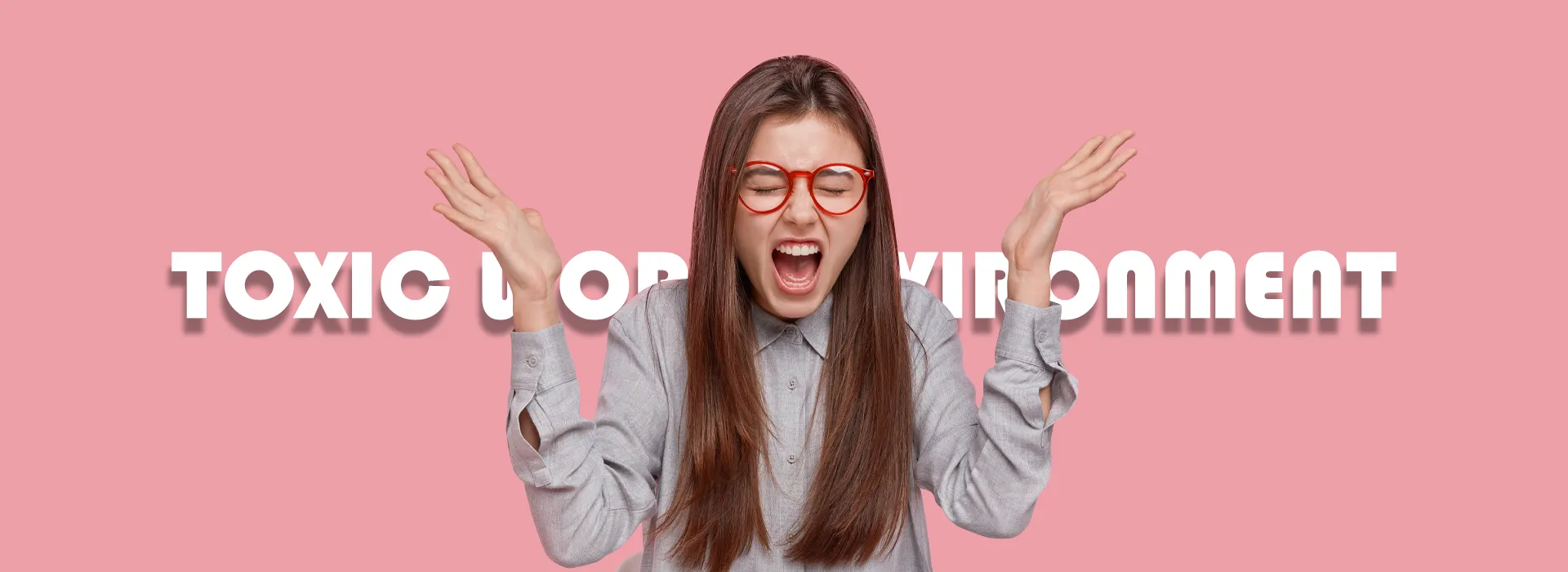Signs Of a Toxic Work Environment and How To Deal
Written by the editorial staff writer at Hola. Medically Reviewed by Amira Shah, MA in Counselling Psychology, Registered Psychotherapist. Blog updated on 24 December, 2025. Originally published on 25 March, 2024.

Contents

Overview
A harmful work environment is more prevalent than many people realise, particularly in Australia, where heavy workloads, increasing living expenses, staff shortages, and heightened pressure have amplified stress levels across numerous sectors. When a workplace turns unhealthy, it can impact both your mental and physical health. The crucial first step is to identify the initial warning signs so that you can intervene before burnout or enduring mental health problems arise.
What is a toxic work environment?
A toxic work environment is any setting where the culture, systems, or behaviours consistently undermine employees’ psychological or physical safety and well-being. Unlike a “busy” workplace, which can still maintain respect and support, a toxic environment leaves you feeling exhausted, anxious, and isolated.
Key consequences include:
- Decreased productivity and motivation
- Increased stress and anxiety
- Lower job satisfaction
- Strain on personal relationships
- Higher risk of burnout and mental health difficulties over time
Signs
Poor communication
Breakdowns in communication are often one of the earliest indicators of a toxic workplace.
- Confusing or vague instructions
- Insufficient transparency from management
- Regular mixed messages or abrupt changes without clarification
Bullying, harassment, or intimidation
Aligned with the Fair Work Australia’s1 definition of workplace bullying, these behaviours create fear, stress, and long-term psychological harm.
- Ongoing or unjust criticism
- Public humiliation or shaming
- Passive-aggressive conduct
- Harassment based on gender, culture, appearance, or other personal attributes
Unrealistic workloads and expectations
Excessive demands without adequate support can quickly lead to exhaustion and disengagement.
- Constant overtime or unreachable deadlines
- Disregard for work-life balance
- Pressure to “push through” without proper support
Lack of leadership support
Poor leadership often intensifies workplace stress and discourages employees from speaking up.
- Managers who overlook or dismiss issues
- Minimal training or guidance provided
- Favouritism, inequitable opportunities, or inconsistent treatment
High employee turnover
Frequent staff changes can signal deeper cultural or management problems within an organisation.
- Frequent resignations
- Constant new hires replacing previous staff
- Loss of seasoned employees, resulting in team pressures
Blame culture
A workplace that focuses on blame rather than solutions can erode trust and collaboration.
- Punishing mistakes instead of addressing them
- Colleagues competing rather than collaborating
- Fear-based management and a lack of accountability at higher levels
Low morale and negativity
Ongoing negativity can significantly affect motivation, engagement, and mental wellbeing.
- Ongoing complaining and frustration
- Reduced motivation or engagement
- A general sense of disconnection from the team
Effects
Emotional effects:
A toxic workplace can have a profound impact on emotional wellbeing.
- Anxiety
- Irritability
- Feeling a sense of dread before work
Physical effects:
Chronic stress in the workplace often manifests physically over time.
- Headaches
- Sleep disturbances
- Persistent fatigue
Professional effects:
Ongoing exposure to a toxic environment can undermine professional confidence and performance.
- Low self-confidence
- Reduced productivity
- Difficulty maintaining focus
Personal effects:
The impact of a toxic workplace often extends beyond working hours and into personal life.
- Strained relationships
Emotional exhaustion and burnout can spill into all areas of life, affecting overall health, relationships, and quality of life beyond the workplace.
Ready for positive change? Start your mental health care plan here.
How to deal
Managing a toxic work environment involves setting boundaries, protecting yourself, and seeking appropriate support. While not every situation can be resolved, taking proactive steps can help reduce harm and improve your wellbeing.
Establish personal boundaries
Clear boundaries help protect your time, energy, and mental health in a challenging workplace.
- Limit after-hours emails or calls.
- Prioritise tasks and avoid chronic overcommitment.
- Politely but clearly decline unreasonable workload demands.
Keep thorough documentation
Accurate records can provide important protection if issues need to be escalated formally.
- Save emails, messages, and instructions.
- Record dates, times, and individuals involved in incidents.
- This documentation can serve as evidence if concerns need to be raised.
Address concerns professionally
Raising issues calmly and constructively can sometimes lead to positive change.
- Select a calm and appropriate moment to discuss concerns.
- Clarify how the situation is affecting your work and wellbeing.
- Avoid emotional or accusatory language.
- Focus on facts and specific examples.
Develop a support network
Support from others can help reduce isolation and provide emotional reassurance.
- Speak with trusted colleagues.
- Share your feelings with supportive friends or family.
- Seek mental health support if work begins to affect your wellbeing.
Utilise employee assistance programs (EAP)
Many Australian workplaces offer free, confidential counselling through Employee Assistance Programs (EAP). These services can help with stress management, conflict resolution, and emotional support.
Be aware of your workplace rights in Australia
Understanding your rights can empower you to take action when necessary.
- The Fair Work Act protects employees from bullying, harassment, and unsafe work practices.
- You can raise concerns with HR, WorkSafe, or the Fair Work Ombudsman if required.
- Employees have a legal right to a safe and respectful workplace.
When it may be time to leave
In some cases, despite your best efforts, a workplace may not improve.
Signs it might be time to move on:
- Your mental health is declining.
- You feel persistently fearful or unsafe.
- There is a lack of support from leadership.
- Carefully plan your exit to protect your financial and emotional wellbeing.
Healthy vs toxic workplaces
Understanding the differences between healthy and toxic workplaces can help you assess your own environment.
| Healthy workplaces | Toxic workplaces |
| Open communication | Secrecy and mixed messages |
| Respectful culture | Bullying and intimidation |
| Reasonable workload | Chronic overwork |
| Supportive leadership | Blame and fear |
| Recognition and career growth | Stagnation and constant criticism |
When to consult a GP
Workplace stress can have serious mental and physical health consequences if left unaddressed.
Answer by Amira, an expert therapist – If you are experiencing symptoms of burnout, difficulty sleeping, feeling overwhelmed, or persistent anxiety related to your job, it is important to seek professional help. A GP or psychologist can assess the impact of workplace stress, recommend treatment options, and support your mental wellbeing. Early intervention may help prevent long-term health issues.
How Hola Health can help
Hola Health offers accessible support for individuals experiencing work-related stress and mental health concerns.
- Online GP consultations from the comfort of your home
- Mental health assessments and referrals
- Support for job-related stress, anxiety, sleep disturbances, and burnout
- Medicare-subsidised Mental Health Treatment Plans
Conclusion
A toxic work environment can gradually erode your wellbeing, confidence, and quality of life. Recognising the warning signs early allows you to protect yourself, establish boundaries, and seek support when needed. Whether you work toward improving your situation or plan a healthy exit, you are not alone, and help is available to guide you towards a safer and more supportive work life.
FAQs
How can I determine if my workplace is harmful?
If you regularly feel exhausted, intimidated, unsupported, or anxious at work, these may be indicators of a harmful work environment.
Can a harmful work environment impact my health?
Yes. It can contribute to headaches, sleep problems, anxiety, depression, and chronic burnout.
What are my rights if I am experiencing bullying at work?
You can report concerns to human resources, WorkSafe, or the Fair Work Ombudsman. Under Australian law, you have the right to a safe and respectful workplace.
Should I quit a harmful workplace right away?
Not necessarily. It is important to assess the situation, document concerns, seek advice, and plan your departure carefully.
Can a GP assist with stress related to work?
Yes. A GP can assess your symptoms, provide treatment options, refer you to a psychologist, and create a Mental Health Treatment Plan.
Take control of your mental health. Begin your care plan now.
Reference
Fair Work Act - reference linkWhat we treat
- Cough
- Nausea & vomiting
- Fever
- Hayfever
- Fatigue
- Sore throat
- Acne
- Hair loss
- Gout
- Eczema
- Rosacea
- Sunburn
- UTI
- Erectile dysfunction
- Contraception
- Morning sickness
- Morning after pill
- Prostate health
- Anxiety
- Depression
- Stress
- Grief & loss
- Antidepressants
- Premature ejaculation
- Asthma
- Blood pressure
- Blood thinners
- Diabetes
- Cholesterol
- Migraines & headaches
- Allergies
- Body ache
- Heartburn & reflux
- Sleep disorder
- Pain relief
- Gastro
Related Articles
Work-Life Balance: 10 Easy Habits to Prioritise Mental Health
What is generalised anxiety disorder? Treatment options in Australia
Disclaimer
This blog is for general informational purposes only and does not indicate that Hola Health provides all treatments or preventive measures mentioned. It is not intended to be a substitute for professional medical advice. Always seek the guidance of your doctor or other qualified health professional with any questions you may have regarding your health or a medical condition. For emergencies please immediately contact 000. Any medical topics discussed are intended to educate, not to imply availability through Hola Health.
 Facebook
Facebook  X
X  Copy Link
Copy Link



